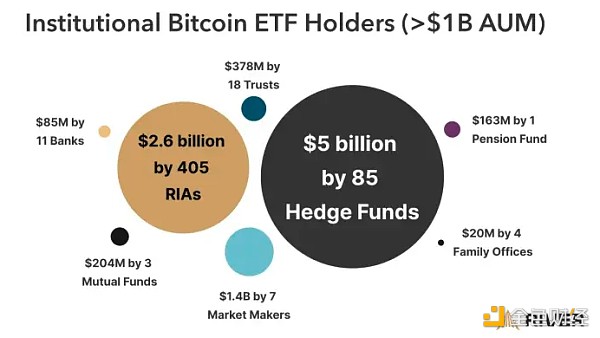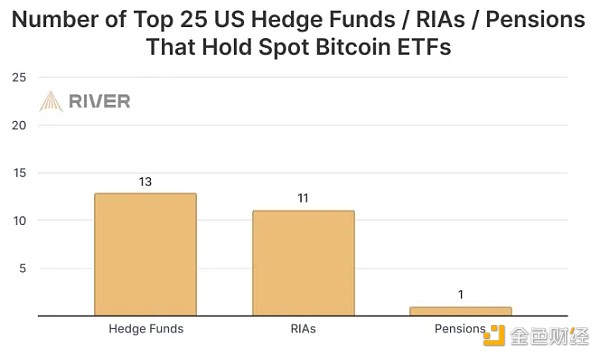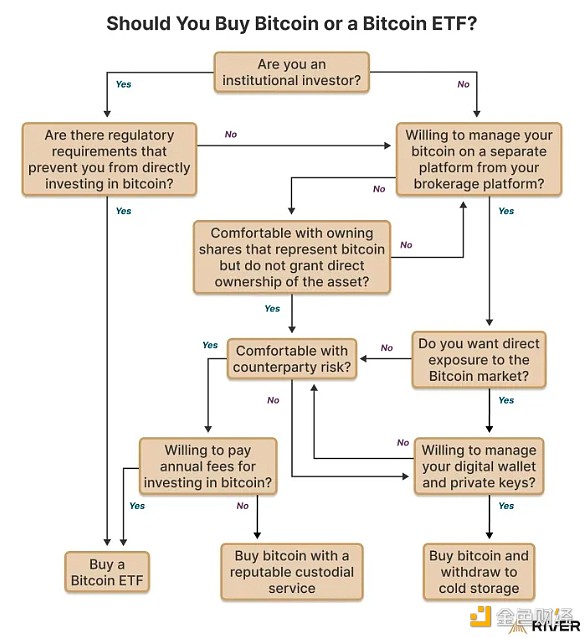Author: Sam Baker, Bitcoin Magazine; Translator: Wuzhu, Golden Finance
For Bitcoin to be truly adopted by institutions, it only takes the introduction of an exchange-traded fund (ETF) product that minimizes risk and is easy to use. In January of this year, the U.S. Securities and Exchange Commission approved nine new ETFs that invest in Bitcoin through the spot market, which is a big improvement over the futures ETFs that began trading in 2021. In the first quarter of trading, the scale and number of institutional allocations to these ETFs exceeded general expectations. BlackRock's ETF alone set a record for the shortest time for ETF assets to reach $10 billion.
In addition to the eye-popping AUM figures for these ETFs, last Wednesday was the deadline for institutions with more than $100 million in assets to report their holdings to the U.S. Securities and Exchange Commission through 13F filings. These documents reveal a complete picture of who owns Bitcoin ETFs - and the results are nothing short of optimistic.
Wide Institutional Adoption
In past years, if an institutional investor reported owning Bitcoin, it would make news and even shake up the market. Just three years ago, Tesla's decision to add Bitcoin to its balance sheet caused Bitcoin to rise more than 13% in a single day.
2024 is clearly different. As of Wednesday, we now know that 534 independent institutions with more than $1 billion in assets chose to start allocating to Bitcoin in the first quarter of this year. From hedge funds to pension funds and insurance companies, the breadth of Bitcoin adoption is remarkable.

Source: River
More than half of the 25 largest hedge funds in the United States now hold Bitcoin, with the most notable being Millennium Management's $2 billion position. In addition, 11 of the 25 largest registered investment advisors (RIAs) now hold Bitcoin.

Source: River
Why is a Bitcoin ETF so attractive to institutions that are just buying Bitcoin?
Large institutional investors are slow to act, coming from a financial system with deep roots in tradition, risk management and regulation. It takes months or even years of committee meetings, due diligence and board approvals for pension funds to update their portfolios, and these approvals are often repeated multiple times.
To gain exposure to Bitcoin by buying and holding actual Bitcoin requires a comprehensive review of multiple exchange providers (e.g., Galaxy Digital), custodians (e.g., Coinbase), and forensic services (e.g., Chainalysis), in addition to developing new accounting, risk management processes, and more.
In contrast, gaining exposure to Bitcoin by purchasing an ETF from Blackrock is easy. As Lyn Alden said on the TFTC podcast, “From a developer’s perspective, an ETF is basically an API to the fiat system. It just makes Bitcoin more accessible to the fiat system than before.”
That’s not to say that ETFs are the ideal way for people to gain exposure to Bitcoin. In addition to the management fees that come with owning an ETF, such a product comes with a number of tradeoffs that could compromise the core value that Bitcoin offers—a currency that can’t be bought. While these tradeoffs are beyond the scope of this article, the flowchart below describes some of the factors to consider.

Why Didn’t Bitcoin Rise Further This Quarter?
With such high ETF adoption, it may be surprising that Bitcoin’s price is only up 50% year to date. In fact, if 48% of the top hedge funds are now allocated to the fund, how much upside is really left?
While the range of holdings in ETFs is broad, the average allocation of institutions that hold them is fairly limited. Among the large ($1 billion+) hedge funds, RIAs, and pensions that have made allocations, the weighted average allocation is less than 0.20% of AUM. Even Millennium’s $2 billion allocation represents less than 1% of its reported 13F holdings.
Q1 2024 will therefore be remembered as the period when institutions “came out of zero.” As for when they’ll get out of the testing waters? Only time will tell.
 Catherine
Catherine
 Catherine
Catherine Weiliang
Weiliang Alex
Alex Miyuki
Miyuki Kikyo
Kikyo Kikyo
Kikyo Weiliang
Weiliang Alex
Alex Miyuki
Miyuki Weiliang
Weiliang